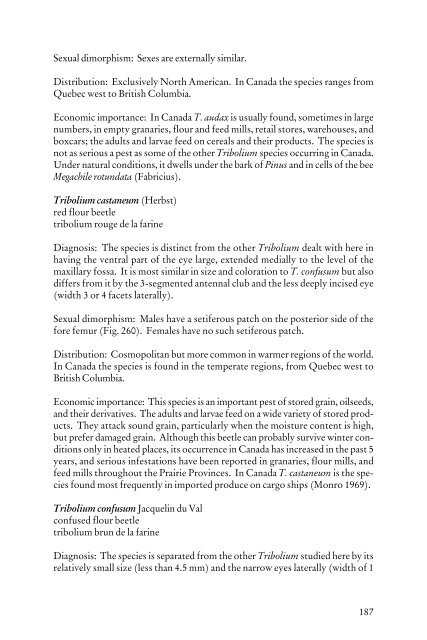Beetles Identification Guide
Beetles Identification Guide
Beetles Identification Guide
You also want an ePaper? Increase the reach of your titles
YUMPU automatically turns print PDFs into web optimized ePapers that Google loves.
Sexual dimorphism: Sexes are externally similar.<br />
Distribution: Exclusively North American. In Canada the species ranges from<br />
Quebec west to British Columbia.<br />
Economic importance: In Canada T. audax is usually found, sometimes in large<br />
numbers, in empty granaries, flour and feed mills, retail stores, warehouses, and<br />
boxcars; the adults and larvae feed on cereals and their products. The species is<br />
not as serious a pest as some of the other Tribolium species occurring in Canada.<br />
Under natural conditions, it dwells under the bark of Pinus and in cells of the bee<br />
Megachile rotundata (Fabricius).<br />
Tribolium castaneum (Herbst)<br />
red flour beetle<br />
tribolium rouge de la farine<br />
Diagnosis: The species is distinct from the other Tribolium dealt with here in<br />
having the ventral part of the eye large, extended medially to the level of the<br />
maxillary fossa. It is most similar in size and coloration to T. confusum but also<br />
differs from it by the 3-segmented antennal club and the less deeply incised eye<br />
(width 3 or 4 facets laterally).<br />
Sexual dimorphism: Males have a setiferous patch on the posterior side of the<br />
fore femur (Fig. 260). Females have no such setiferous patch.<br />
Distribution: Cosmopolitan but more common in warmer regions of the world.<br />
In Canada the species is found in the temperate regions, from Quebec west to<br />
British Columbia.<br />
Economic importance: This species is an important pest of stored grain, oilseeds,<br />
and their derivatives. The adults and larvae feed on a wide variety of stored products.<br />
They attack sound grain, particularly when the moisture content is high,<br />
but prefer damaged grain. Although this beetle can probably survive winter conditions<br />
only in heated places, its occurrence in Canada has increased in the past 5<br />
years, and serious infestations have been reported in granaries, flour mills, and<br />
feed mills throughout the Prairie Provinces. In Canada T. castaneum is the species<br />
found most frequently in imported produce on cargo ships (Monro 1969).<br />
Tribolium confusum Jacquelin du Val<br />
confused flour beetle<br />
tribolium brun de la farine<br />
Diagnosis: The species is separated from the other Tribolium studied here by its<br />
relatively small size (less than 4.5 mm) and the narrow eyes laterally (width of 1<br />
187
















